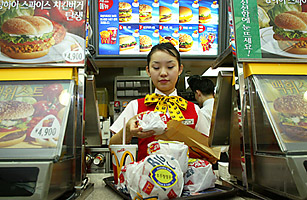
Since its founding in 1948, McDonald’s has grown from a family burger stand to a global fast-food behemoth, with more than 30,000 locations in 118 countries. Those nations, however, are about to have their ranks reduced by one: the Golden Arches are pulling up stakes in Iceland this week, and Icelanders pining for a Big Mac and large fries will soon be going hungry. The global chain says it is shuttering its three stores in the capital, Reykjavik, citing the collapse of the local economy and the high cost of imports. The closures aren’t a first for the company: McDonald’s has pulled out of Bolivia, Jamaica and a handful of other countries due to poor sales. But the setback is decidedly unusual for the world’s largest fast-food chain.
Dick and Mac McDonald opened their eponymous burger stand in 1948 in San Bernardino, Calif. Under the guidance of Ray Kroc, a onetime milkshake-mixer salesman wowed by the restaurant’s success, McDonald’s franchises grew swiftly: by the end of the 1960s, there were more than 1,000 across the U.S. The first international franchise opened in 1967 in British Columbia, and was followed by another in Costa Rica later that year. From there, the chain spread steadily: over a six-month period in 1971, Golden Arches popped up on three new continents, as stores launched in Japan, Holland and a suburb of Sydney. A Brazilian McDonald’s opened in 1979, bringing Ronald McDonald to South America for the first time. McDonald’s reached its sixth continent in 1992, with the opening of a restaurant in Casablanca, Morocco. Four years later, the company heralded the expansion into its 100th nation, Belarus, and claimed to be opening a new restaurant somewhere in the world every three hours.
By the end of 2008, McDonald’s had grown to 31,967 locations in 118 countries. Of those, only about 14,000, or 45%, were in the U.S. With 58 million daily customers worldwide, McDonald’s are now so ubiquitous around the globe that The Economist publishes a global ranking of currencies’ purchasing power based on the prices charged at the local Mickey D’s, dubbed the Big Mac Index. That’s not to say that every nation carries the same menu items: choices vary widely depending on location. The biggest seller in France after the Big Mac is a mustard-topped burger called Le Royal Deluxe. Some Asian locations serve fried shrimp in a Big Mac roll, while McDonald’s in India don’t serve beef at all, relying instead on burgers made from veggies, rice and beans. Brazilian McDonald’s offer baked banana pies for dessert.
Not everyone in the world has been happy to greet Ronald McDonald when he moves to town. Many see the corporate juggernaut as a symbol of American economic and cultural chauvinism, and European nations in particular have viewed American-style fast food as an insult to their cherished national cuisines. Bermuda banned all fast-food restaurants to squelch a McDonald’s planned for the island. A French farmer, Jose Bove, became something of a national hero in 1999 after he and a band of activists destroyed a McDonald’s under construction to protest globalization and “bad food.” The next year, a bomb detonated in a French McDonald’s, killing a 27-year-old employee. No one claimed responsibility.
But regardless of whether you like their food or their policies, McDonald’s is still widely seen as one of the true vanguards of peaceful globalization. After 14 years of discussions with the Kremlin, the Soviet Union’s first McDonald’s opened in Moscow in 1990 — a move credited with helping thaw Cold War tensions. Columnist and author Thomas Friedman has asserted that nations with McDonald’s locations do not go to war with each other — the so-called Golden Arches Theory of Conflict Prevention — although that thesis notably collapsed in the case of the 2008 war between Russia and Georgia. There are other signs that overseas resentment of the burger giant has softened. A McDonald’s is slated to open in November in a shopping area beneath one of France’s most treasured cultural meccas — the Louvre — but the news has hardly caused a stir in the City of Light. Bank employee Laurent Mortin told the New York Times he didn’t have a problem with the American import: “It’s more of a real lunch than eating a sandwich in the street, and it doesn’t take as much time as sitting in a restaurant.”
Read “Latte with Fries? McDonald’s Takes Aim at Starbucks.”
See TIME’s Pictures of the Week.